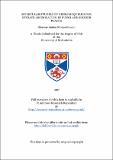Files in this item
Molecular studies of genes required for nitrate assimilation in fungi and higher plants
Item metadata
| dc.contributor.advisor | Kinghorn, Jim | |
| dc.contributor.author | Kana'n, Ghassan Jadou Mousa | |
| dc.coverage.spatial | 384 p. | en_US |
| dc.date.accessioned | 2018-06-20T12:51:32Z | |
| dc.date.available | 2018-06-20T12:51:32Z | |
| dc.date.issued | 1997 | |
| dc.identifier.uri | https://hdl.handle.net/10023/14338 | |
| dc.description.abstract | Nitrate assimilation is an extremely important part of the nitrogen cycle and is carried out by most bacteria, fungi and plants. A relatively short catalytic pathway reduces nitrate to nitrite (via nitrate reductase activity) and then nitrite to ammonium ions (via nitrite reductase activity) which are converted into organic nitrogen by further metabolic pathways. A considerable amount of information is known about the biochemistry, genetics and recently, the molecular biology of these two enzymes. Much less is known about the transport of nitrate and nitrite into cells as well as the synthesis of the molybdenum cofactor needed for nitrate reductase catalytic activity. Research work reported in this thesis focus on these latter two processes in the eukaryotic model organisms. Aspergillus nidulans and to a lesser extent Arahidopsis thaliana. Genetic characterisation of 47 crn mutants shows that there are three additional genes (i.e. to the original identified crnA gene) likely to be involved in nitrate transport. These additional genes are unlinked to each other or to crnA. Although it was shown that the nitrate uptake into cells of these mutants are lower than the wild-type, their exact involvement in nitrate transport requires their molecular cloning. Certain mutations generated in the crnA gene have been investigated at the molecular level and the disruptions in the protein determined. During the genetic studies of crn mutants, two other genes were postulated. The first is chlA, mutation which results in resistance to chlorate (unlike the wild-type) and caesium (like the wild-type). The second is cesA mutation. These latter mutants lead to caesium sensitivity but are chlorate sensitive like the wild-type. These two genes are unlinked to crnA, crnB, crnC and crnD genes. The bases of these phenotypes is unclear and need further investigation. A study of nitrite uptake was undertaken which showed that wild-type A. nidulans has an active nitrite transport system. The activity of this system is repressed by ammonium and is nitrate induced. Mutants which are hypersensitive to chlorate taken up much higher levels of nitrite as compared to wild-type. 2,082 cnx mutants were isolated and 456 of these were classified as cnxA, cnxB, cnxC, cnxE, cnxF, cnxG and cnxH mutants on the basis of phenotypic complementation. No novel cnx genes were found. More importantly a number of temperature -conditional mutants were isolated, 10 mutants were found to be temperature-sensitives and 10 cryo-sensitives. Of the isolated temperature-sensitives 1 located in cnxA, 1 in cnxB, 2 in cnxC, 1 cnxE, 2 in cnxF and 3 in cnxH. Of the crysosensitives 4 in cnxB, 3 in cnxC and 3 in cnxF. These mutants will be particularly useful to relate structure and function when data is forthcoming regarding their protein sequence. Two temperature-sensitive mutants, cnxH255 and cnxH261 showed reduced nitrate reductase thermostability which indicates that the cnxH product could be associated with the NR protein. One of the Aspergillus nidulans genes required for the synthesis of the molybdenum cofactor was isolated using molecular self-cloning transformation approaches. This gene, cnxH, was sequenced at the nucleotide level as well as three mutant alleles (one temperature sensitive and two temperature non-conditional). The results show that the cnxH product is the homologue of Escherichia, coli moaE whose role is in the synthesis of the molybdenum cofactor specifically to convert the large subunit to active converting factor. Sequence analysis of the two non-conditional mutants indicates that such mutants generated stop codons which provides little or no information about the structure / function relationships. The mutation in the temperature-sensitive mutant lead to a glycine insertion at position +443 and it is postulated that this additional amino acid caused the heat liability of the NR enzyme. Studies of cnxH expression show that the cnxH is in very low abundance and not regulated at the transcriptional level at least since similar transcript levels were seen in both nitrate and ammonium grown cells- conditions, which making difference for nitrate reductase activity. Finally attempts at isolating Arabidopsis thaliana cnx genes failed. | en_US |
| dc.language.iso | en | en_US |
| dc.publisher | University of St Andrews | |
| dc.subject.lcc | QK753.N5K2 | en |
| dc.subject.lcsh | Plants—Effect of nitrogen on | en |
| dc.title | Molecular studies of genes required for nitrate assimilation in fungi and higher plants | en_US |
| dc.type | Thesis | en_US |
| dc.type.qualificationlevel | Doctoral | en_US |
| dc.type.qualificationname | PhD Doctor of Philosophy | en_US |
| dc.publisher.institution | The University of St Andrews | en_US |
This item appears in the following Collection(s)
Items in the St Andrews Research Repository are protected by copyright, with all rights reserved, unless otherwise indicated.

